The diffuse interstellar medium
Disk galaxies have obvious spiral patterns which are made extremely evident by the bright, young stars associated with ongoing star formation within the arms. However, much of the interstellar medium (the dust and gas within a galaxy) is locatesd between spiral arms, and is involved in much less violent star formation. I've studied the UV emission from such regions in order to account for how much of this diffuse inter-arm UV comes directly from young stars, intermediate age stars, and what fraction might be light scattered off dust grains. The results of this work are soon to be published.
Emission from small dust grains known as poly-aromatic hydrocarbons (PAHs) is often used as a star-formation tracer in local galaxies. It is preferred to the total infrared emission as such a tracer because it more selectively absorbs in the UV, where young hot stars emit much of their light. However, old stars will still contribute to the PAH emission in galaxies with active star formation. For a local spiral galaxy, NGC 628, I accounted for how much PAH emission was likely powered by stars of various ages, as well as the total infrared emission, shown in the bottom two bars of this figure:

Crocker et al. 2013 presents this work on NGC 628 and outlines the process of attributing PAH emission to various stellar populations. Ongoing work is currently applying the same technique to 12 other local spiral galaxies.
Early-type galaxies
I am particularly interested in the cold interstellar medium of early-type galaxies (ellipticals and lentiuculars). Historically, early-type galaxies were considered cold-gas free and therefore 'dead' and unable to make new generations of stars. Present-day research, including my own (Crocker et al. 2008, 2009, 2011), shows that this is not the case. Many early-type galaxies contain either atomic or molecular gas, or both. Additionally, many of those with molecular gas show signs of ongoing star-formation.
Now knowing that early-type galaxies are capable of forming stars, a crucial question becomes if they do so in the same manner as the much-studied spiral and starburst counterparts. One way to examine this question is to determine whether they follow the same star-formation law (Schmidt-Kennicutt law) as other star-forming galaxies. Crocker et al. 2011 first put a number of early-type galaxies on a Schmidt-Kennicutt plot and found that within the errors early-type galaxies did follow a similar trend as spiral and starburst galaxies, using a variety of star-formation rate indicators. An example using a combined Hα and PAH star-formation rate is shown below.
